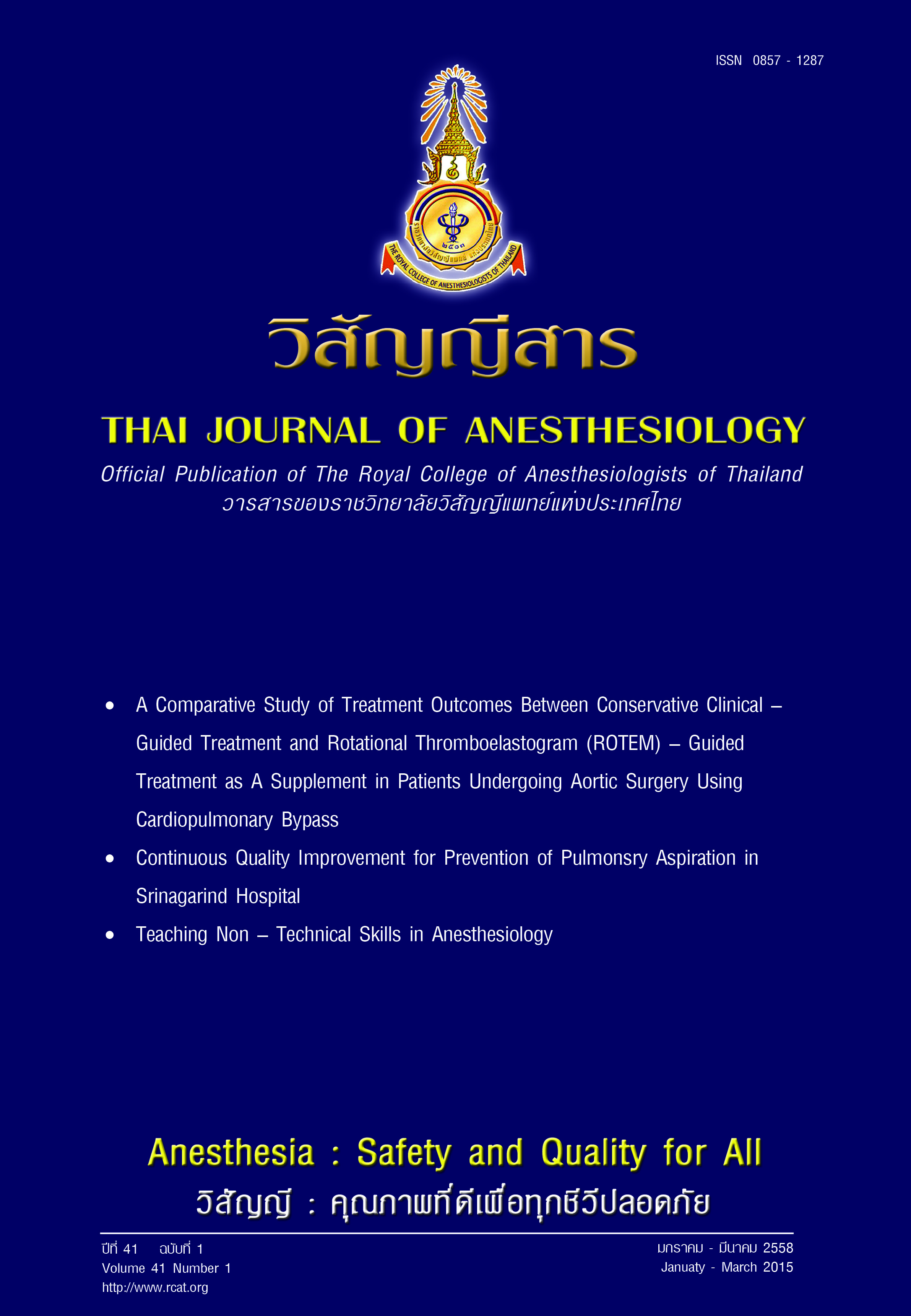Comparison of Emergence Time with Desflurane and Sevoflurane Anesthesia in Patients Undergoing Maxillofacial Surgery
Main Article Content
Abstract
Background: Both Desflurane andSevoflurane are volatile anesthetic with low blood - gas partition coefficient, which allow rapid recovery.
Objectives: To assess the emergence characteristics after anesthesia with Desflurane or Sevoflurane.
Methods: In a prospective, randomized controlled study, 70 nonpremedicated patients undergoing elective maxillofacial surgery were allocated into two groups: Group Des (35 patients) received Desflurane for maintenance of anesthesia. Group Sevo (35 patients) received Sevoflurane for maintenance of anesthesia. Intraoperative analgesia and neuromuscular block was achieved using fentanyl and cisatracurium. After the anesthetic gas was discontinued, the time from discontinuation of anesthetic gases until patients opened their eyes, followed commands, were able to extubate, recalled name and month of birth was measured.
Results: Patients receiving desflurane recovered 3 - 5 minutes quicker in the operating room than patients receiving sevoflurane. They opened eyes 3.49 minutes sooner (p < 0.001; 95% CI, - 4.20 to - 2.41), obeyed commands 3.91 minutes sooner (p < 0.001; 95% confidence interval [CI], - 4.69 to - 2.78), were extubated 4.19 minutes sooner (p < 0.001; 95% CI, - 5.17 to - 3.12), and were oriented 4.97 minutes sooner (p < 0.001; 95% CI, - 5.63 to - 3.47).
Conclusions: The use of Desflurane resulted in faster emergence from anesthesia as compared to sevoflurane.
เปรียบเทียบยาดมสลบไอระเหยชนิด Desflurane และ Sevoflurane กับระยะเวลาการฟื้น จากการสลบในผู้ป่วยที่มารับการผ่าตัดบริเวณใบหน้าและกระดูกขากรรไกร
บทนำ: Desflurane และ Sevoflurane เป็นยาระงับความรู้สึกชนิดไอระเหยที่มีความสามารถในการ ละลายต่ำในเลือด (blood/gas partition coefficients: 0.42 และ 0.69 ตามลำดับ) จึงทำให้ฟื้นจากการสลบได้เร็ว
วัตถุประสงค์: เพื่อศึกษาระยะเวลาการฟื้นตัวจากการสลบในการผ่าตัดบริเวณใบหน้าและกระดูกขากรรไกร เปรียบเทียบระหว่างกลุ่มที่ได้รับยาดมสลบไอระเหยชนิด Desflurane และ Sevoflurane ระหว่างผ่าตัด โดย พิจารณาจากความเร็วและคุณภาพการฟื้นตัว
วิธีการศึกษา: เป็นการศึกษาแบบไปข้างหน้า ทำการสุ่มแบบเปิด ซองจดหมายโดยมีกลุ่มเปรียบเทียบ ในผู้ป่วยที่มาผ่าตัดแบบไม่เร่งด่วน จำนวน 70 ราย แบ่งเป็น 2 กลุ่ม กลุ่มละ 35 ราย กลุ่ม Desได้รับยาสลบไอระเหยชนิด Desflurane กลุ่ม Sev ได้รับยาสลบไอระเหยชนิด Sevoflurane ผู้ป่วย ทุกรายได้รับยาระงับปวดเฟนทานิลและยาหย่อนกล้ามเนื้อชนิด cisatracurium ในระหว่างการผ่าตัด ทำการ ประเมินข้อมูลเกี่ยวกับระยะเวลานับจากปิดยาดมสลบไอระเหยจนผู้ป่วยลืมตา, ระยะเวลานับจากปิดยาดมสลบ ไอระเหยจนผู้ป่วยสามารถทำตามคำสั่งได้ (เช่นกำมือผู้ประเมินได้แน่น อ้าปาก แลบลิ้น), ระยะเวลานับจากปิด ยาดมสลบไอระเหยจนสามารถถอดท่อหายใจออก, ระยะเวลานับจากปิดยาดมสลบไอระเหยจนผู้ป่วยสามารถ บอกชื่อตนเอง และเดือนเกิดได้
ผลการศึกษา: ผู้ป่วยที่ใช้ยาดมสลบไอระเหยชนิด Desflurane ระหว่างการผ่าตัด ฟื้นจากการสลบในระยะเวลาที่เร็วกว่าผู้ป่วยที่ใช้ยาดมสลบไอระเหยชนิด Sevoflurane ประมาณ 3 - 5 นาที สามารถลืมตาได้เร็วกว่า 3.49 นาที (p < 0.001; 95% CI, - 4.20 to - 2.41), ทำตามสั่งเช่นกำมือผู้ประเมินได้แน่น อ้าปาก แลบลิ้นได้เร็วกว่า 3.19 นาที (p < 0.001; 95% confidence interval [CI], - 4.69 to - 2.78), ถอดท่อหายใจ ได้เร็วกว่า 4.19 นาที (p < 0.001; 95% CI, - 5.17 to - 3.12) และสามารถบอกชื่อตนเองและเดือนเกิดได้เร็วกว่า 4.97 นาที (p < 0.001; 95% CI, - 5.63 to -3.47)
สรุป: ผู้ป่วยที่ใช้ยาดมสลบไอระเหยชนิด Desflurane ระหว่าง การผ่าตัดฟื้นจากการสลบในระยะเวลาที่เร็วกว่าผู้ป่วยที่ใช้ยาดมสลบไอระเหยชนิด Sevoflurane


